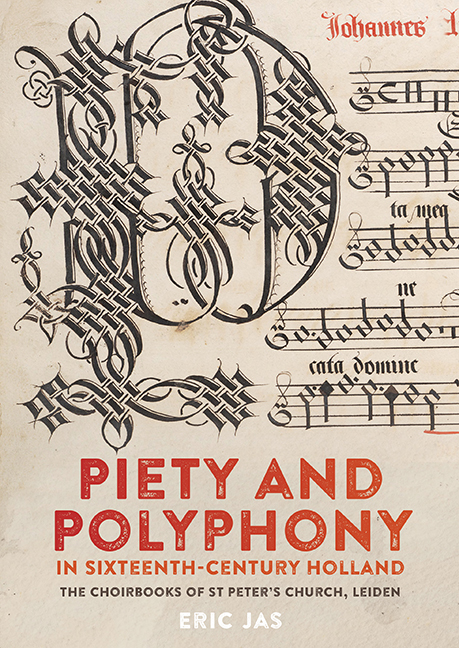Book contents
- Frontmatter
- Contents
- List of Illustrations
- Preface and Acknowledgements
- List of Abbreviations
- Introduction
- 1 The Zeven-Getijdencolleges
- 2 The Seven Hours in St Peter's Church at Leiden
- 3 The Choirbooks of St Peter's Church
- 4 The Repertoire of the Choirbooks
- Epilogue
- Appendix 1 Archival Documents
- Appendix 2 Descriptions and Inventories of the Choirbooks
- Appendix 3 Watermarks
- Alphabetical List of Compositions
- Alphabetical List of Composers
- Concordant Manuscripts and Printed Editions
- Bibliography
- Index
- Studies in Medieval and Renaissance Music
2 - The Seven Hours in St Peter's Church at Leiden
Published online by Cambridge University Press: 17 October 2019
- Frontmatter
- Contents
- List of Illustrations
- Preface and Acknowledgements
- List of Abbreviations
- Introduction
- 1 The Zeven-Getijdencolleges
- 2 The Seven Hours in St Peter's Church at Leiden
- 3 The Choirbooks of St Peter's Church
- 4 The Repertoire of the Choirbooks
- Epilogue
- Appendix 1 Archival Documents
- Appendix 2 Descriptions and Inventories of the Choirbooks
- Appendix 3 Watermarks
- Alphabetical List of Compositions
- Alphabetical List of Composers
- Concordant Manuscripts and Printed Editions
- Bibliography
- Index
- Studies in Medieval and Renaissance Music
Summary
IN the Middle Ages the small village of Leiden developed from a hamlet near Zoeterwoude into a town that was, by late medieval standards, of significant proportions. Around 1514 Leiden was the largest city in the county of Holland – with a little over 14,000 inhabitants – but still considerably smaller than, for example, Antwerp and Ghent. The expansion of Leiden in the late Middle Ages was not so much the result of a natural rise in population as it was due to the settlement of many immigrants who were attracted by Leiden's favourable location on the Rhine. In the thirteenth and fourteenth centuries it was predominantly Flemish textile workers from established centres, such as Ypres, who came to Leiden. With these craftsmen came the broadcloth industry, which would define the image of the town for years to come. A cutthroat competition with the English, who were able to supply broadcloth at competitive prices, marked a new era at the end of the fifteenth century during which the importance of the textile industry diminished. However, the tide turned and Leiden continued to grow. The real Golden Age of Leiden did not set in until its citizens had withstood two sieges by the Spanish soldiers of Philip II in 1573–1574. The city was rewarded for its heroic resistance with the foundation of the first university on (present-day) Dutch soil.
Art has always been one of Leiden's great selling points. Two of its inhabitants, Cornelis Engebrechtsz. (c. 1462–1527) and his pupil Lucas van Leyden (1494–1533), were among the finest artists in the sixteenth-century northern Netherlands. Some of the greatest painters of the famous Dutch Golden Age were born in Leiden: Jan van Goyen (1596–1656), Rembrandt van Rijn (1606–1669), Gerard Dou (1613–1675) and Jan Steen (1625/56–1679). But with respect to music, sources are rather scarce. The life of Cornelis Schuyt (1557–1616) has been documented, but little is known about musical life in the streets, where the civic wind band was heard, or in the three parish churches of the city. From the fourteenth century Leiden had been divided into three parishes. Of the three parish churches St Peter's was not only the largest but also the oldest.
- Type
- Chapter
- Information
- Piety and Polyphony in Sixteenth-Century HollandThe Choirbooks of St Peter's Church, Leiden, pp. 44 - 84Publisher: Boydell & BrewerPrint publication year: 2018



